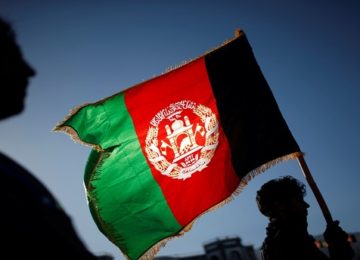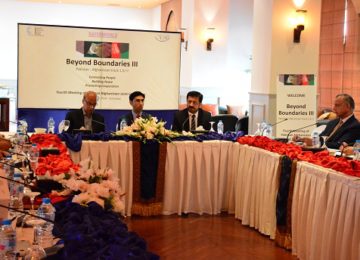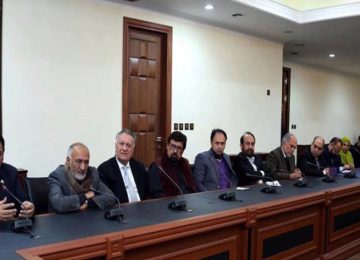For the women forced from their homes and now living in camps in Takhar, Kunduz and elsewhere in Afghanistan, the Taliban operates with impunity.
Fresh speculation erupted in Kabul this week when general John Nicholson, US commander in Afghanistan, claimed that secret peace talks are being held between the Afghan government and the Taliban. This assertion was promptly rejected by Taliban leadership, who have steadfastly insisted upon negotiating directly with the United States. With the launch of the Taliban’s annual spring offensive, it appears to be business as usual in the region, as the Taliban has largely ignored president Ashraf Ghani’s unprecedented peace offer – a move that appears to be a tacit acknowledgement of a growing consensus that there is no military solution to Afghanistan’s long war.
The Taliban – which makes billions of dollars each year producing and trafficking heroin – refers to its members as the “representatives of the will of Afghan nation” who are “revered by the Afghan masses as heroes”. These lofty claims do not reconcile with the experience of the local Afghan women, however, who continue to be abused by the modern-day Taliban.
Earlier this year, I travelled through the northern Afghan provinces of Takhar and Kunduz to conduct field research for Women’s Regional Network (WRN) on the women in IDP (internally displaced persons) camps. Two in particular stood out: the first was a group of UNHCR tents located in an open, desolate field; the second, a camp near Kokcha River which consists of a smattering of crumbling buildings and rubble close to the Tajik border.
It is immediately obvious that the women in these camps harbour intense resentment for the Taliban, tracing back to the Islamists’ brutal rule over the country from 1996 to 2001. Even where they have been forced from their homes due to other factors – by airstrikes, quite often – these women continue to blame the Taliban, intimating that the mere presence of the militants rendered their villages targets. It is safe to say that women, who account for more than half of Afghanistan’s estimated population of nearly 35 million, have no wish to return to the Taliban’s dark rule.
Of the nearly 150 women I interviewed during my two-week tour, many complained that the Taliban routinely steal food. In a country mired in poverty and desolation, this insult cuts deep, particularly during the depths of the harsh northern winter. One woman described Taliban militants going door to door in her village, demanding food at each house and beating any women who dared to refuse.
The Taliban’s leaders and propagandists are eager to shed the brutal image of the past, when they would cut off fingers of women for wearing nail varnish or stone women to death for perceived adultery. Now they are the servants of a benevolent god who wants to bring an end to decades of war, poverty and misery. While there are sections of the population that do support the Taliban, it is difficult to know if they do so under threat of violence or are rather opportunists or ideologues. The disembowelled body of a bicycle thief or a farmer who has switched out of poppy for wheat, hanging from a tree in a village square, sends a powerful message to poverty-stricken, disenfranchised people about where the local power lies.
For the women forced from their homes and now living in camps in Takhar, Kunduz and elsewhere in Afghanistan, the Taliban is already a political force, one which operates with impunity as it administers its own warped brand of power. The Taliban murders its political opponents, destroy grassroots power structures that have held Afghan society together for centuries, denies women and girls the right to education, work or even a voice. It hides behind religion as a veil for its brutality. By offering to bring it in from the cold without any preconditions, Ghani is at risk of legitimising its draconian methods.
If the Taliban truly aspires to move out of the shadows to become a legitimate political movement – the “hero” of the people it believes itself to be – it must move past its extremist tactics and rigid fundamentalism and embrace the more moderate version of Islam that most Afghans practice. It must prove in those areas where it already holds sway that it supports the rights of women to participate freely and openly in society. It must renounce its brutality with proof, not with words. Based on my recent conversations with women in the IDP camps, there is deep doubt it can or will do any of this.
In early May, Kabul was hit by two simultaneous attacks, one claimed by the Taliban and the other by Isis Khorasan. While media and other stakeholders are keen to make the distinction of attribution, most Afghans consider the Taliban and Isis Khorasan to be of the same ilk. Besides, when a loved one is dead, it doesn’t much matter which group is responsible. To Afghans, this violence is the real legacy of the Taliban, and one that is at odds with the government’s offer to meet the militant group at the bargaining table.
This article was originally published by The Independent on June 3, 2018. Original link.
Disclaimer: Views expressed on this blog are not necessarily endorsed or supported by the Center for Research and Security Studies, Islamabad.








